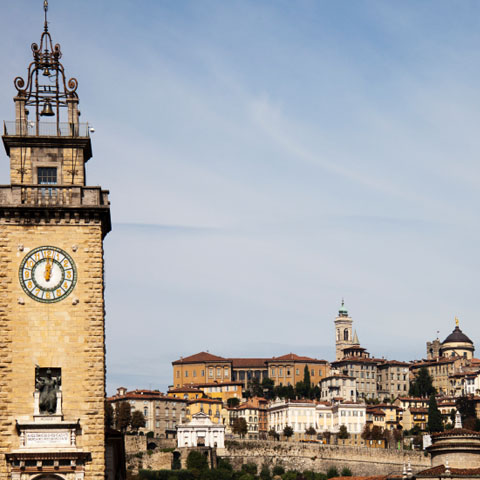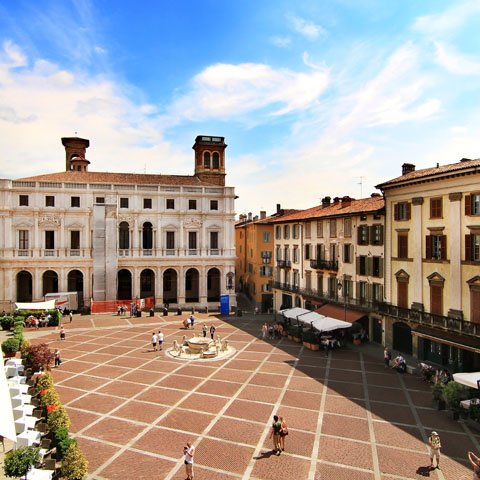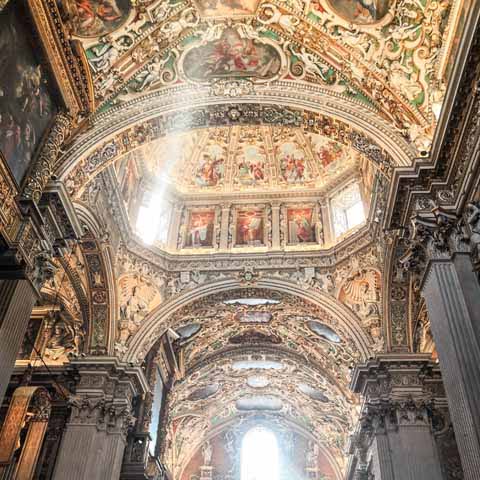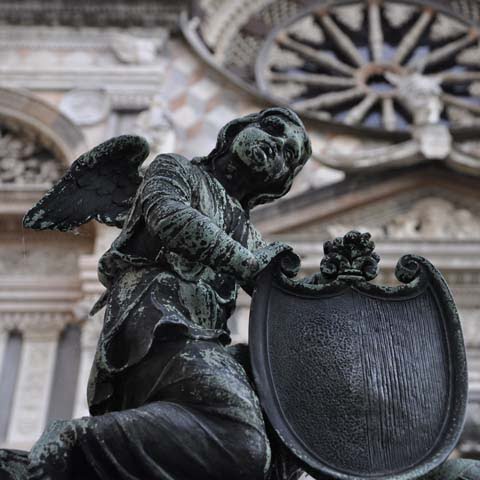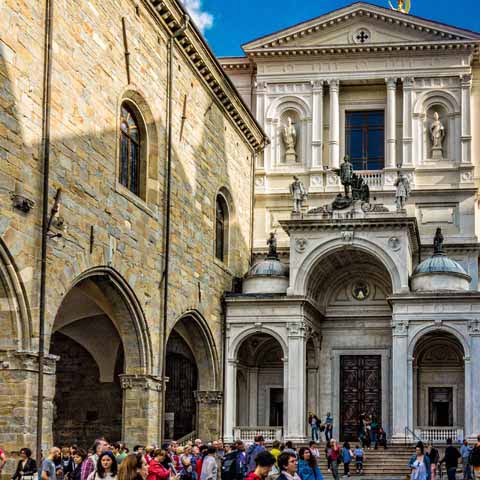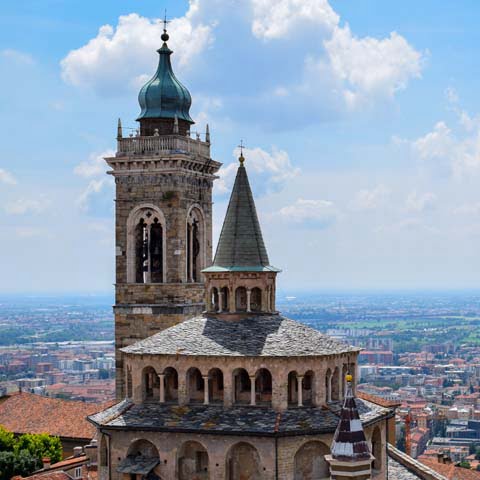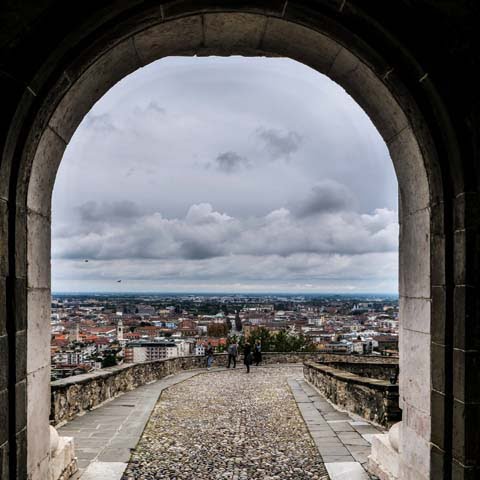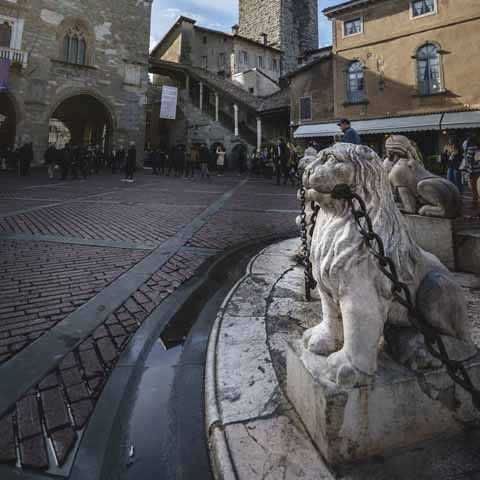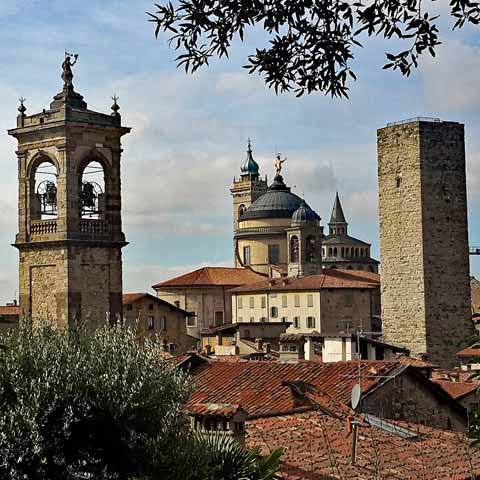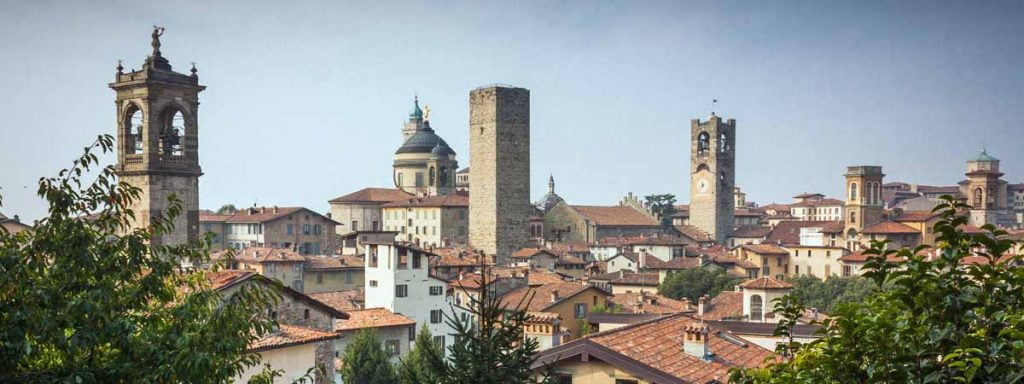Bergamo is one of the most fascinating Italian cities, nonetheless the capital of the homonymous province in Lombardy and the fourth biggest center in the region after Milan, Brescia, and Monza. Divided into the “low” and the “high” city, Bergamo impresses with its natural beauty and rich history.
The Città Alta is located at a higher altitude and houses the majority of the most significant monuments, while the Città Bassa preserves the historic nucleus and the ancient history of the settlement.
As with other Italian cities, the two parts of Bergamo are divided by thick Venetian walls which became a UNESCO World Heritage Site in 2017.
Nicknamed “The City of the Thousand” due to the large number of volunteers who joined the Expedition of the Thousand led by Giuseppe Garibaldi during the Risorgimento, Bergamo has a peculiar name with intricate origins.
There are numerous hypotheses that aim to explain the origin of the name. Some historians claim classic Latin includes the word Bergomum, while other forms of Latin contain the word Bergame used as proper names. This led historians to believe in an Indo-European origin of the name, perhaps Greek and derived from the word pérgamon, meaning citadel or fortress.
A different hypothesis suggests a pre-Latin origin from the word barga, meaning hut. On the other hand, some Ligurian settlements also had similar names, such as Bergima, derived from French.
Historian and politician Bortolo Belotti has approached the definition of the origins of the name from another perspective, suggesting it would probably have derived from a Celtic name, such as Bèrghem; according to this theory, Bergomum would be nothing but a Latinized version of the Celtic proper name.
Given the German influences in the region, other historians noted that in modern German berg means mountain, while heim means house. According to their theory, Bergamo derives from the association of the two nouns; however, there is no evidence of Germanic settlements in the region before the Roman conquest.
Regardless of the origins of the name, what is certain is that Bergamo boasts a rich and fascinating history worth delving into.
PREHISTORY OF BERGAMO
Due to the scarcity and inconsistency of the historiographical documentation, it is impossible to define the foundation of Bergamo chronologically. It is believed the settlement arose as a spontaneous primitive urban agglomeration rather than through a real act of foundation in the pre-Roman times.
The peculiarity of the prehistoric settlement is given by the marginal position of the city compared to the position of all major settlements preferred by the proto-historic cultures. However, through archaeological findings, it is possible to speak of a transalpine cultural center involved in a relationship with both the Etruscans and the Celtic cultures established in the area.
Pliny the Elder is the first historian to mention the settlement of Bergamo in his writings; citing the Roman politician Cato, Pliny speaks of the settlement of Parra, perhaps established by the Indo-European tribe of the Orobii. Supposedly, the origins of Bergamo are, therefore, Greek. However, there is scarce evidence to support this theory.
Some historians even suggest it is more logical to suppose that the Orobii were of Ligurian descent, or that they were a Gallic tribe.
The writings of Livius also suggest a proto-historic presence of the Ligurians and Umbrians in the Bergamo area, supported majorly by the undoubted arrival in the region of the Gauls first, and then of the Romans.
Yet, both the name of the city and the archaeological findings suggest an initial Ligurian settlement without a real foundation or urban structure.
How Bergamo was born is wrapped in the shadow of history, so all theories speaking of the ancient settlement are only hypothetical.
Yet, at the chronological level, the only Indo-European civilization characterized by rural tribal nuclei of limited extension that can be identified in the area during the early Iron Age is the culture of Golasecca.
It is very likely that Bergamo did not assume the connotation of a real urban area during the Etruscan period, mainly because it is unlikely that the Etruscans exercised their cultural influence in the Po Valley during the sixth century BC.
Moreover, evidence shows the culture of iron in Lombardia and Liguria regions was spread by the Golasecca during the Eneolithic era.
Although Roman historians mention the presence of the Etruscans in the region, archaeological evidence found throughout the region also suggests otherwise. In fact, the process of colonization of the territory does not correspond to the Etruscan practices.
Therefore, the Etruscan presence in Bergamo must not be understood as real political domination; from a historical standpoint though, it is hard to understand who and in what circumstances established the first settlement in the area.
Despite the intricate origins, what is certain is that archaeological evidence suggests the presence of the Celts in the region beginning with the fifth century BC. Settled in the Po Valley and occupying the areas of Bergamo, Brescia, Vicenza, and Verona, they permanently changed the original name of the settlement from Parra to Bergheim, which soon became the most important city of the region, thanks to its strategic position.
The Celtic peoples fortified the center with huts and various dwellings, and it is believed Bergamo even held an important political and administrative role.
On the background of peaceful and fruitful relationships between the Gauls and the Etruscans, Bergamo flourished as an intermediary trade center towards central Europe, while both civilizations benefited from cohabitation and collaboration.
This, however, does not exclude the possibility of conflicts between the two cultures, and therefore the expulsion of the Etruscans by the invading Gauls, as mentioned by the Roman historian Marco Giuniano Giustino.
According to the chronicles, it is clear there were many struggles between the two main cultures, and the expulsion of the Etruscans took place in different ways, which are less dramatic and sudden than one could imagine.
The main occupation of the population in the region was agriculture while the settlements were more rural in nature than urban.
Shortly after 390 BC, the city became the scene of clashes between the Celtic populations and the veterans of Rome who saw immense defensive potential in Bergamo. As it happened in all other regions in Italy, the Romans defeated the Gauls and took possession of the territory, razing the existing structures to the ground and building new castles and defensive edifices.
From then on, the city thrived under the Roman Empire until its disintegration a few centuries later.
HISTORY OF BERGAMO
With the disintegration of the Roman Empire, Bergamo passed under the rule of the Lombards in 568 AD, becoming the seat of one of the most important duchies in the kingdom. The Lombards left their mark on the territory, establishing juridical institutions connected to the management of family assets and the juridical status of women and marriage. Evidence about the importance of these institutions can still be found in the Statutes of Bergamo promulgated in the Venetian age.
With the defeat of the Lombards in 774, Bergamo turned into a free county; however, soon after, the city passed under the domination of the Franks, then under the Germans. The events took a profound turnover on the ruling class, with bishops and governors named predominantly from the Franks.
During the tenth century, the power of the counts over the rural territory was reduced and more power was placed in the hands of the church. However, the bishop defended the city from sieges and incursions of the Huns.
In 904, the Bishop Adalberto was granted full jurisdiction by King Berengar I, including military and civil power. However, with the death of Adalberto, during the period of struggle, the new bishop of Bergamo was deprived of these privileges.
The sudden emptiness of power that came to be created was filled by the representatives of the most prestigious aristocratic families of the city, who took administrative control over the civic and military powers, establishing a collegiate body.
This marked the birth of the Municipality of Bergamo and the beginning of a period of peace based on a feud the citizens established among themselves. The pact was based on laws, civil rights, honor, piety, and pure harmony.
The institutional structure of the municipal powers also started to take shape in this period. In fact, this is when the Civic Assembly, the Council of the Elders, and the Consulate were formed.
With the advent of the Municipality, the city also gained a strong desire for expansion; Bergamo’s mercantile economy and a notable growth in population attest to the success of these expansionist ambitions.
During the same period, Bergamo also witnessed a series of interventions on the urban landscape which gave life to the medieval city, most of which was beautifully preserved, gaining international fame.
The wealth of the city did not pass unnoticed for the church. New mendicant orders, the Dominicans and the Franciscans settled here, with the subsequent rise of new churches, squares, and edifices.
At the same time, the community also started to organize itself, establishing trade corporations, confraternities, and consortia developed to assist the poor and increase the wealth of the entire area.
This period of municipal autonomy continued until the end of the thirteenth century when increasingly cruel infightings engaged all major families of the city in struggles for control of power.
The two major players were the Suardi family, representing the Ghibellines, and the Colleoni, representing the Guelphs. In an attempt to overcome the power of their competitor, the Suardi requested the intervention of the Visconti of Milan. This move marked the beginning of a period of decline.
Bergamo began losing its strength and autonomy, and in 1331 King John of Bohemia was asked to intervene as a peacemaker between the two parts.
This move imposed peace, but ended communal rights and liberties. During this era, La Rocca, a symbol of the new noble power was built.
In the following year, Azzone Visconti seized Bergamo and Visconti’s domination began.
During their reign, the citadel was built and the fortification of the Castle of San Vigilio was also completed. The Visconti ruled the area for more than two decades, until 1354 when a new statutory system entrusted the city to a noble podestà whose role was to preside over the ancient municipal bodies, the Council of the Elders, and the General Council.
Under these conditions, Bergamo became a pawn in the diplomatic and military game of the great Italian states, which for a century, engaged in clashes one against the other to establish a balance of forces.
At the end of these struggles, Bergamo became part of the Venetian dominion from 1427 and remained under the rule of the Republic of Venice until 1797.
As part of the Republic of Venice, Bergamo becomes a border city. Thus, the construction of imposing city walls was fundamental.
The construction began in 1561 and brought solid clarification of the new strategic function, the central power assigned to the city.
In parallel with the edification of the walls, Venice also imposed new institutional structures that brought to the city two rectors named by the capital.
However, once Venice gained the guarantee that the city would provide the requested military control and pay its tax obligations, Venice granted Bergamo with a large autonomy, leaving untouched the ancient municipal magistracies under the discreet supervision of the rectors.
This wise administration led by Venice, dictated by a thriving economy and loyalty of the citizens allowed the cultural and economic relations between Bergamo and Venice to grow. During the sixteenth and seventeenth century, Bergamo’s artistic culture knew moments of great splendor.
With the fall of the Republic of Venice in 1797, Bergamo followed the fate of most Northern Italian territories and passed under the rule of Napoleon in the Cisalpine Republic. The French influence penetrated all areas of life, including a new reorganization of municipal power.
From 1814 to 1859, Bergamo ended up under Austrian rule and became part of the Lombard-Veneto Kingdom. In the struggles between the Napoleonic and Austrian periods, the city assumed a new role with respect to the past. From a border town, it became an important city in Lombardy.
From the second part of the nineteenth century, Bergamo entered an economic development phase, mainly a result of the inflow of capital from neighboring Switzerland. This led to the establishment of considerable manufacturers and resulted in subsequent industrial development.
During this time, Città Alta lost its predominant role over the rest of the urban agglomeration while the new Città Bassa became increasingly important.
These transformations in the economic and urban field took place in a period of strong political changes; in fact, on June 8, 1859, Giuseppe Garibaldi made his triumphal entrance in Bergamo. This marked the end of foreign domination, asked by the people for decades.
In the upcoming years, Bergamo contributed the highest number of volunteers to Garibaldi’s expeditions, which honored the city with the title of the “City of the Thousand.”
During World War I, Bergamo demonstrated incredible heroism; the city is also renowned for its resistance against the fascist movement during World War II.
Today, Bergamo’s economy focuses on tertiary services, mainly banking and retail associated with a powerful industrial sector throughout the province. Thanks to its cultural and historical wealth, the city’s tourism sector is also steadily growing.
ARCHAEOLOGY IN BERGAMO
Like many major cities in Italy, Bergamo boasts rich archaeological evidence of its past, although the roots of the city are almost impossible to determine due to a general lack of prehistoric cultural evidence able to assign the settlements to a specific civilization.
Nonetheless, a noteworthy archaeological area lays in Piazza Vecchia, in the old heart of the city. Excavations conducted here during the twenty-first century revealed the existence of a protohistoric settlement.
Evidence from Roman times is abundant and scattered throughout the city, while the city preserves many edifices and some burial sites from the Middle Ages.
The Civic Archaeological Museum and the Civic Museum of Sciences are also noteworthy, both housing multiple artifacts and fossils discovered in the region.
Travel Guides
The Lombardy Region of Italy
The Cities of Lombardy, Italy
